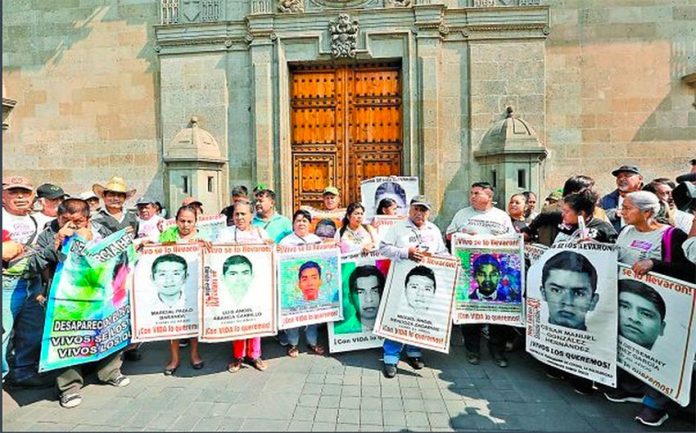Almost six years after 43 teaching students disappeared in Iguala, Guerrero, the federal government announced on Tuesday that the remains of one of them had been identified.
Omar Gómez Trejo, the special prosecutor in charge of the reexamination of the disappearance and presumed murder of the Ayotzinapa rural teachers college students, said that forensic scientists at the University of Innsbruck in Austria had identified a bone fragment found in a ravine in Cocula, Guerrero, as the remains of Christian Alfonso Rodríguez Telumbre.
Gómez noted that the bone fragment was not found in the Cocula municipal dump or the nearby San Juan River and therefore the “historical truth” – the former government’s official version of events of what happened to the students on September 26, 2014 – “is over.”
The former government claimed that the students were intercepted by corrupt municipal police in Iguala after they commandeered a bus to travel to a protest in Mexico City. According to the “historical truth,” the police handed the students over to a local crime gang, the Guerreros Unidos, whose members killed them, burned their bodies in the Cocula dump and scattered their ashes in the nearby San Juan River.
However, the current federal government rejected its predecessor’s version of events and launched a new investigation shortly after President López Obrador took office in December 2018. Many people suspect that the army played a role in the students’ disappearance.
Gómez said that forensic experts from Argentina had confirmed the findings of the scientists in Innsbruck, adding that more remains will be sent to Austria for analysis.
A report by the Argentine Forensic Anthropology Team (EAAF), which has collaborated with Mexican authorities on the investigation into the Aytotzinapa case, said the bone fragment identified as the remains of Rodríguez had no signs of exposure to fire, debunking the “historical truth” proffered by former attorney general Jesús Murillo Karam in January 2015.
Seen by the newspaper Milenio, the EAAF report said the identified bone fragment came from the student’s foot. Given the bone’s preserved state, the forensic scientists in Innsbruck were able to obtain DNA from it that allowed them to identify the student.
After comparing the DNA with genetic samples provided by Rodríguez’s three sisters and parents, the scientists concluded that there was “very strong evidence” that the bone fragment was the student’s remains.
An analysis conducted by the EAAF found that there was a probability in excess of 99.9% that the bone fragment corresponded to Rodríguez.
The bone fragment and other human remains were found by federal authorities in November last year. All told, more than 100 bone fragments were found in a ravine located about a kilometer from the Cocula dump, Milenio reported.

The remains of six bodies – three that were found in the ravine and three found on a property near Iguala – were sent to Austria in March.
At least five bone fragments sent away for analysis showed no signs of fire damage, Milenio said.
Rodríguez, who was 21 at the time of his disappearance, is the third of the 43 students to be identified through DNA analysis of discovered remains.
The other two were Alexander Mora Venancio and Jhosivani Guerrero de la Cruz. However, Guerreo’s family refused to accept the accept the scientists’ findings.
Deputy Interior Minister for Human Rights Alejandro Encinas said Tuesday that the veracity of the identification of Guerrero was under investigation.
The positive identification of Rodríguez is the first major breakthrough for the federal government, which has conducted searches for the students’ remains in hundreds of locations across several municipalities in Guerrero.
One theory is that the students were separated after their abduction and killed in different locations.
Encinas said President López Obrador will meet with the families of the victims on Friday and share details with them about the progress of the investigation. He said the family of Rodríguez was told about his identification two days before the news was publicly announced.
Attorney General Alejandro Gertz Manero said last week that authorities had established a new theory about what happened to the 43 students after their abduction in September 2014.
“We already know what happened, we know who ordered it, who covered it up … and [why] they did what they did,” he said.
Gertz also said that prosecutors had requested 46 warrants for the arrest of municipal officials in Guerrero in connection with the students’ disappearance.
The authorities have already obtained arrest warrants against former Attorney General’s Office officials, including the ex-head of the Criminal Investigation Agency, Tomás Zerón, who is believed to have fled Mexico.
Zerón is wanted on charges of torturing people detained in connection with the case, forced disappearance, evidence tampering and altering a crime scene.
The presumed leader of the Guerreros Unidos, the gang that allegedly killed the students, was arrested in late June after almost six years on the run.
José Angel Casarrubias Salgado, also known as “El Mochomo,” was released from prison last week after his mother allegedly paid multi-million-peso bribes to the presiding judge’s staff. However, he was immediately rearrested and remains behind bars.
The Ayotzinapa case is the biggest stain on the record of former president Enrique Peña Nieto, whose administration was plagued by scandals.
The disappearance of the students triggered some of the biggest protests seen in Mexico in recent years, with demonstrators calling for the resignation of Peña Nieto. But the ex-president survived the uprising and went on to complete his six-year term in 2018 before vanishing from public life.
Source: Milenio (sp)
